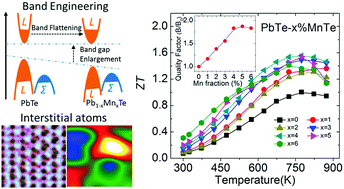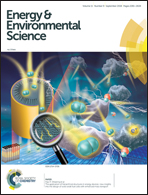Realizing high performance n-type PbTe by synergistically optimizing effective mass and carrier mobility and suppressing bipolar thermal conductivity†
Abstract
Thermoelectric materials enable direct inter-conversion between electrical energy and thermal energy. The conversion efficiency is limited by their complex interdependent thermoelectric parameters. Here, we report that the electrical and thermal transport properties of n-type PbTe can be simultaneously improved by introducing just one component, MnTe. We obtained a maximum ZT of ∼1.6 at 773 K and an average ZTave of >1.0 at 300–873 K in n-type MnTe alloyed PbTe. This remarkably enhanced performance arises from the triple functions of MnTe alloying: (1) making the conduction band flatter to increase the effective mass from 0.31 me to 0.45 me; (2) enlarging the band gap of PbTe to suppress the bipolar thermal conductivity; and (3) introducing point defects instead of nanoprecipitates to reduce the lattice thermal conductivity while maintaining a relatively high carrier mobility. Our results indicate that high performance can be achieved in n-type PbTe by integrating different but synergistic concepts.



 Please wait while we load your content...
Please wait while we load your content...